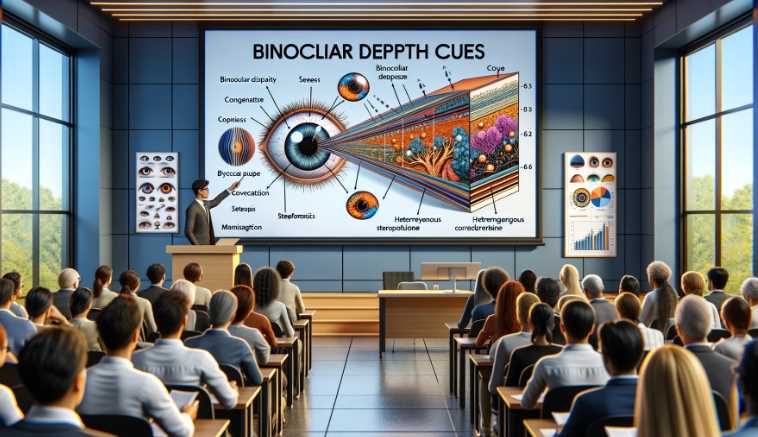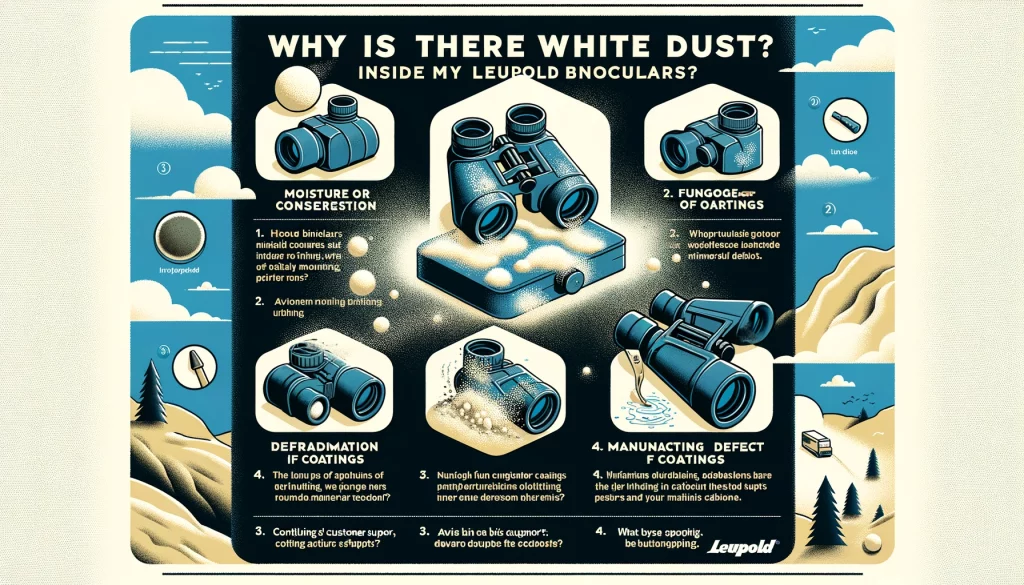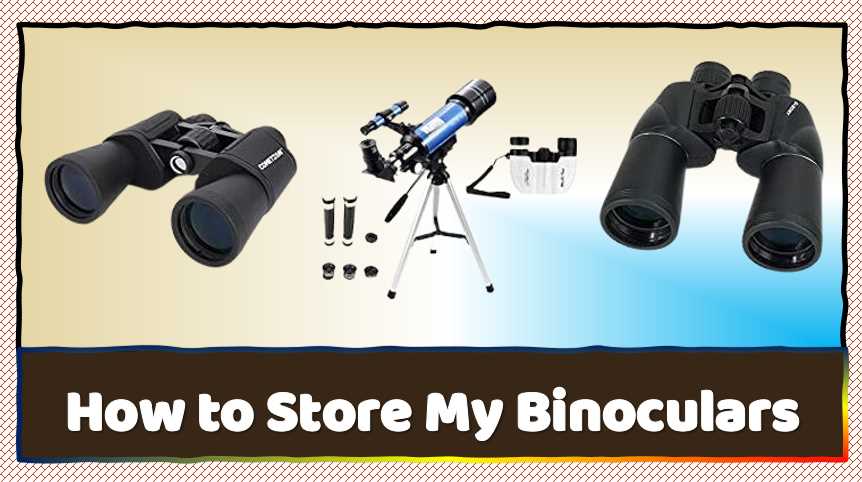Binocular depth cues are visual cues to depth and distance from how the left and right eyes view slightly different images of the same scene, allowing the brain to perceive depth in three dimensions.
Binocular depth cues rely on the fact that each eye captures a slightly different perspective of the world due to their separation (binocular disparity). The brain combines these two slightly different images to create a perception of depth, enabling us to gauge distances and perceive objects in three-dimensional space. This process is known as stereopsis.
| Binocular Depth Cue | Description |
|---|---|
| Binocular Disparity | The difference in the retinal images between the left and right eyes, allowing the brain to compute depth and create a three-dimensional perception of the scene. |
| Convergence | The degree to which the eyes turn inward to focus on a nearby object, providing a cue for depth perception. As objects get closer, the eyes converge more, and as objects move farther away, the eyes diverge. |
| Accommodation | The adjustment of the lens shape in each eye to focus on objects at different distances, contributing to depth perception. |
| Stereopsis | The fusion of the slightly different images from each eye to perceive depth, creating a sense of three-dimensional space. |
| Heteronymous Correspondence | The process by which the brain matches corresponding points in the left and right retinal images, aiding in the perception of depth. |
These binocular depth cues work together to provide a rich and accurate perception of depth and spatial relationships in our visual environment.
Types of Binocular Depth Cues
Convergence
Convergence, the inward turning of our eyes when focusing on nearby objects, is like a silent dance between our eyes and brain. Think about reading a captivating book—the way your eyes effortlessly converge on the text, creating a vivid picture in your mind. It’s this convergence that paints the canvas of our surroundings with depth.
Binocular Disparity
Binocular disparity, the slight difference in images captured by each eye, plays a starring role in our visual spectacle. Picture catching a ball mid-air—the brain seamlessly fuses these disparate images, enabling us to gauge the ball’s distance accurately. It’s like a built-in 3D movie playing in our minds.
Accommodation
Accommodation, the lens adjusting its focus to objects at different distances, is the unsung hero working in harmony with convergence and binocular disparity. When you shift your gaze from a close-up object to a distant landscape, your eyes and lens engage in a ballet of focus, ensuring a smooth transition in your visual narrative.
Neural Mechanisms Behind Binocular Depth Perception
Brain Processing of Binocular Information
Step into the enchanting realm of the visual cortex, where the magic of binocular depth perception unfolds. Neural networks within the visual cortex choreograph a symphony of signals, seamlessly integrating convergence, binocular disparity, and accommodation. It’s like a behind-the-scenes masterpiece, orchestrating our perception of depth.
Development of Binocular Depth Perception
Embark on the journey of depth perception development, a tale that begins in infancy. Watch as infants, with eyes working independently, gradually master the art of convergence and binocular disparity. It’s a coming-of-age story for our visual system, shaping our ability to navigate the world in three dimensions.
Practical Applications of Binocular Depth Cues
Virtual Reality (VR) and Augmented Reality (AR)
Dive into the world of VR and AR, where binocular depth cues take center stage. Imagine donning a VR headset, and suddenly, you find yourself immersed in a virtual world with depth and dimension. These technologies leverage binocular cues to create an experience so real, it’s almost surreal.
Medicine and Ophthalmology
In the realm of medicine, binocular depth cues play a crucial role in diagnosing and treating vision disorders. Join me on a visit to the ophthalmologist’s office, where convergence and binocular disparity become diagnostic tools. It’s a testament to how understanding these cues opens doors to clearer vision and improved eye health.
Factors Influencing Binocular Depth Perception

Age and Binocular Depth Cues
As the years gracefully add up, our depth perception undergoes changes. Accompany me through the chapters of aging eyes, where the lens loses some flexibility, impacting convergence and accommodation. It’s a journey that highlights the importance of adapting strategies to maintain optimal depth perception.
Environmental Factors
Lighting conditions, the surroundings we find ourselves in—they all play supporting roles in our visual narrative. Explore how adequate lighting enhances our perception of depth, and how the characteristics of our environment influence binocular cues. It’s a story of adaptability, where our eyes navigate diverse settings with finesse.
Limitations and Challenges
Binocular Depth Cues and Visual Illusions
Yet, in the world of perception, challenges emerge. Discover the delicate dance between binocular depth cues and visual illusions, where the brain’s interpretation can be swayed. It’s a journey into the realm of optical illusions, reminding us of the fine line between what we see and what is.
Comparison with Monocular Depth Cues
Overview of Monocular Depth Cues
As we broaden our horizon, let’s explore the synergy between monocular and binocular depth cues. Delve into the definition and examples of monocular cues, understanding how they coalesce to create a comprehensive perception of depth. It’s a fusion of visual elements that paints a complete picture.
Combined Use for Enhanced Perception
In the grand tapestry of perception, monocular and binocular cues intertwine, each complementing the other. Walk with me through scenarios where the combined use of both cues becomes paramount. It’s like having a well-balanced team, each player contributing their unique strengths for optimal performance.
Future Directions and Technological Advancements
Advances in Binocular Depth Cue Research
Peer into the crystal ball of research trends, where scientists delve into the intricacies of binocular depth cues. It’s a glimpse into the future, where emerging technologies and tools promise to refine our understanding. The possibilities are endless, as we envision a world where innovation aligns seamlessly with ethical standards.
Ethical Considerations
In the ever-evolving landscape of technology, ethical considerations become our guiding compass. Join me in a reflection on privacy concerns and responsible use of binocular depth cues. It’s a call to balance innovation with ethical imperatives, ensuring that our quest for knowledge respects the sanctity of individual privacy.
How do Binocular Depth Cues contribute to our perception of depth?
Binocular Depth Cues play a crucial role in our perception of depth by utilizing the slight differences in the images captured by our left and right eyes. These cues help our brain to interpret the distance and spatial relationships of objects in our environment.
| Binocular Depth Cue | Description |
|---|---|
| Retinal Disparity | The difference in the position of an object’s image on the retinas of the left and right eyes. The brain uses this information to calculate depth. |
What is Retinal Disparity, and how does it work as a Binocular Depth Cue?
Retinal Disparity refers to the variation in the location of an object’s image on the retinas of the left and right eyes. This cue allows the brain to perceive depth by comparing the disparities between the images captured by each eye.
| Retinal Disparity | Function |
|---|---|
| Binocular Disparity | Discrepancy in the visual information between the two eyes, enabling depth perception. |
Can you explain Convergence as a Binocular Depth Cue?
Certainly. Convergence is another binocular depth cue that involves the rotation of both eyes towards each other when focusing on nearby objects. This convergence angle provides the brain with information about the depth and distance of the object being observed.
| Convergence | Significance |
|---|---|
| Ocular Adjustment | The degree of inward rotation of the eyes to focus on close objects, aiding in depth perception. |
How does Binocular Depth Perception differ from Monocular Depth Perception?
Binocular Depth Perception relies on the combined input from both eyes to perceive depth, while Monocular Depth Perception utilizes visual cues that can be perceived with just one eye. Binocular cues, such as retinal disparity and convergence, provide a more accurate depth perception compared to monocular cues.
| Depth Perception Type | Key Characteristics |
|---|---|
| Binocular | Utilizes input from both eyes, providing more accurate depth perception. |
| Monocular | Relies on cues that can be perceived with one eye, offering less precision in depth perception. |
What is the significance of Stereopsis in Binocular Depth Perception?
Stereopsis is the visual perception of depth produced by the brain’s interpretation of the slightly disparate images received from each eye. This binocular depth cue, particularly important for tasks like judging distances accurately, enhances our overall depth perception.
| Stereopsis | Importance |
|---|---|
| Depth Discrimination | Enables the brain to differentiate between objects in three-dimensional space. |
How do Binocular Depth Cues impact 3D vision and depth in virtual reality (VR) experiences?
Binocular Depth Cues are essential for creating a realistic sense of depth and dimension in virtual reality. By mimicking the natural processes of the human eyes, VR systems utilize cues like retinal disparity and convergence to enhance the user’s perception of depth within the virtual environment.
| VR Depth Perception | Binocular Cues Integration |
|---|---|
| Realism Enhancement | Incorporates retinal disparity and convergence for a more authentic 3D experience. |
How does Age impact the effectiveness of Binocular Depth Cues?
As individuals age, changes in vision, including reduced eye muscle flexibility, can affect the effectiveness of binocular depth cues. This can result in challenges in perceiving depth accurately.
| Age Group | Binocular Depth Cues Impact |
|---|---|
| Young Adults | Generally experience optimal functioning of binocular depth cues. |
| Elderly Individuals | May experience diminished effectiveness due to age-related vision changes. |
Are there any disorders affecting Binocular Depth Perception?
Yes, certain visual disorders can impact binocular depth perception. Strabismus, for example, causes misalignment of the eyes, affecting the brain’s ability to combine images properly and resulting in impaired depth perception.
| Visual Disorder | Impact on Binocular Depth Perception |
|---|---|
| Strabismus | Misalignment of the eyes leading to impaired binocular depth perception. |
How do Binocular Depth Cues contribute to sports performance?
Binocular depth cues are crucial in sports, aiding athletes in judging distances accurately. For instance, in sports like baseball or golf, where precise depth perception is essential, athletes rely on cues such as retinal disparity to gauge the distance to the target.
| Sports Application | Binocular Depth Cue Utilization |
|---|---|
| Baseball | Judging the distance between the pitcher and batter. |
| Golf | Assessing the distance to the golf ball and the hole. |
Can corrective lenses affect Binocular Depth Perception?
Corrective lenses, such as glasses or contact lenses, can influence binocular depth perception positively by addressing visual impairments. However, improperly prescribed or outdated lenses may impact the accuracy of binocular depth cues.
| Corrective Lenses Impact | Binocular Depth Perception Influence |
|---|---|
| Proper Prescription | Enhances binocular depth perception by correcting vision. |
| Outdated Prescription | May lead to inaccuracies in depth perception. |
How do Binocular Depth Cues contribute to driving safety?
In driving, binocular depth cues are crucial for assessing distances between vehicles, judging speed, and determining the proximity of objects on the road. This information is vital for making quick and accurate decisions while driving.
| Driving Safety Aspect | Binocular Depth Cue Contribution |
|---|---|
| Distance Estimation | Helps drivers accurately judge distances between vehicles and obstacles. |
| Speed Perception | Contributes to assessing the speed of oncoming traffic. |
Is it possible to improve Binocular Depth Perception through training?
Yes, certain exercises and activities can enhance binocular depth perception. Vision therapy, including eye exercises that promote convergence and improve eye coordination, can be beneficial for individuals experiencing difficulties in binocular depth perception.
| Improvement Methods | Binocular Depth Perception Enhancement |
|---|---|
| Vision Therapy | Involves exercises to strengthen eye muscles and improve binocular vision. |
| 3D Vision Training | Utilizes stereoscopic exercises to enhance depth perception. |
Conclusion
As we reach the summit of our exploration, let’s reflect on the profound impact of binocular depth cues on our visual experience. From the dance of convergence to the symphony of neural processing, these cues shape the way we perceive and interact with the world. So, let’s continue to delve deeper, unraveling the mysteries that enrich our understanding of the marvels of human vision.
Resources and References
- Types of Binocular Depth Cues
- Neural Mechanisms Behind Binocular Depth Perception
- Nienborg, H., & Cumming, B. G. (2014). Neuronal mechanisms of surround-tuning in macaque V1. Neuron, 84(4), 859–874.
- Cumming, B. G., & DeAngelis, G. C. (2001). The physiology of stereopsis. Annual Review of Neuroscience, 24, 203–238.

I am an enthusiastic student of optics, so I may be biased when I say that optics is one of the most critical fields. It doesn’t matter what type of optics you are talking about – optics for astronomy, medicine, engineering, or pleasure – all types are essential.
Table of Contents


Pingback: What are binocular depth cues in Psychology?
Pingback: What is the difference between monocular and binocular depth cues?
Pingback: Why is the binocular depth system advantageous for predators?
Pingback: Does binocular depth perception apply to photos?
Pingback: Does binocular vision have depth perception?